Repair of endogenous DNA base lesions modulate lifespan in mice
- PMID: 24994062
- PMCID: PMC4125484
- DOI: 10.1016/j.dnarep.2014.05.012
Repair of endogenous DNA base lesions modulate lifespan in mice
Abstract
The accumulation of DNA damage is thought to contribute to the physiological decay associated with the aging process. Here, we report the results of a large-scale study examining longevity in various mouse models defective in the repair of DNA alkylation damage, or defective in the DNA damage response. We find that the repair of spontaneous DNA damage by alkyladenine DNA glycosylase (Aag/Mpg)-initiated base excision repair and O(6)-methylguanine DNA methyltransferase (Mgmt)-mediated direct reversal contributes to maximum life span in the laboratory mouse. We also uncovered important genetic interactions between Aag, which excises a wide variety of damaged DNA bases, and the DNA damage sensor and signaling protein, Atm. We show that Atm plays a role in mediating survival in the face of both spontaneous and induced DNA damage, and that Aag deficiency not only promotes overall survival, but also alters the tumor spectrum in Atm(-/-) mice. Further, the reversal of spontaneous alkylation damage by Mgmt interacts with the DNA mismatch repair pathway to modulate survival and tumor spectrum. Since these aging studies were performed without treatment with DNA damaging agents, our results indicate that the DNA damage that is generated endogenously accumulates with age, and that DNA alkylation repair proteins play a role in influencing longevity.
Keywords: AAG/MPG; Aging; Base excision repair; DNA adducts; DNA glycosylase; Mgmt.
Copyright © 2014 Elsevier B.V. All rights reserved.
Conflict of interest statement
The authors declare that there are no conflicts of interest.
Figures
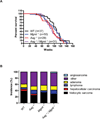
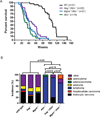
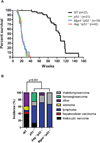
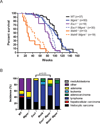
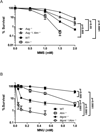
Similar articles
-
DNA repair by MGMT, but not AAG, causes a threshold in alkylation-induced colorectal carcinogenesis.Carcinogenesis. 2015 Oct;36(10):1235-44. doi: 10.1093/carcin/bgv114. Epub 2015 Aug 4. Carcinogenesis. 2015. PMID: 26243310
-
Alkylpurine-DNA-N-glycosylase confers resistance to temozolomide in xenograft models of glioblastoma multiforme and is associated with poor survival in patients.J Clin Invest. 2012 Jan;122(1):253-66. doi: 10.1172/JCI59334. Epub 2011 Dec 12. J Clin Invest. 2012. PMID: 22156195 Free PMC article.
-
MGMT: key node in the battle against genotoxicity, carcinogenicity and apoptosis induced by alkylating agents.DNA Repair (Amst). 2007 Aug 1;6(8):1079-99. doi: 10.1016/j.dnarep.2007.03.008. Epub 2007 May 7. DNA Repair (Amst). 2007. PMID: 17485253 Review.
-
DNA alkylation lesion repair: outcomes and implications in cancer chemotherapy.J Zhejiang Univ Sci B. 2021 Jan 15;22(1):47-62. doi: 10.1631/jzus.B2000344. J Zhejiang Univ Sci B. 2021. PMID: 33448187 Free PMC article. Review.
-
Mismatch repair proteins play a role in ATR activation upon temozolomide treatment in MGMT-methylated glioblastoma.Sci Rep. 2022 Apr 6;12(1):5827. doi: 10.1038/s41598-022-09614-x. Sci Rep. 2022. PMID: 35388070 Free PMC article.
Cited by
-
Cap-independent mRNA translation is upregulated in long-lived endocrine mutant mice.J Mol Endocrinol. 2019 Aug 1;63(2):123-138. doi: 10.1530/JME-19-0021. J Mol Endocrinol. 2019. PMID: 31357177 Free PMC article.
-
A Reassessment of Genes Modulating Aging in Mice Using Demographic Measurements of the Rate of Aging.Genetics. 2018 Apr;208(4):1617-1630. doi: 10.1534/genetics.118.300821. Epub 2018 Feb 14. Genetics. 2018. PMID: 29444805 Free PMC article.
-
Exosomal microRNA-222-3p increases UVB sensitivity of lens epithelium cells by suppressing MGMT.Int Ophthalmol. 2023 May;43(5):1611-1628. doi: 10.1007/s10792-022-02560-7. Epub 2022 Nov 1. Int Ophthalmol. 2023. PMID: 36319884
-
Contributions of DNA repair and damage response pathways to the non-linear genotoxic responses of alkylating agents.Mutat Res Rev Mutat Res. 2016 Jan-Mar;767:77-91. doi: 10.1016/j.mrrev.2015.11.001. Epub 2015 Dec 2. Mutat Res Rev Mutat Res. 2016. PMID: 27036068 Free PMC article. Review.
-
The Shu complex promotes error-free tolerance of alkylation-induced base excision repair products.Nucleic Acids Res. 2016 Sep 30;44(17):8199-215. doi: 10.1093/nar/gkw535. Epub 2016 Jun 13. Nucleic Acids Res. 2016. PMID: 27298254 Free PMC article.
References
Publication types
MeSH terms
Substances
Grants and funding
LinkOut - more resources
Full Text Sources
Other Literature Sources
Research Materials
Miscellaneous

